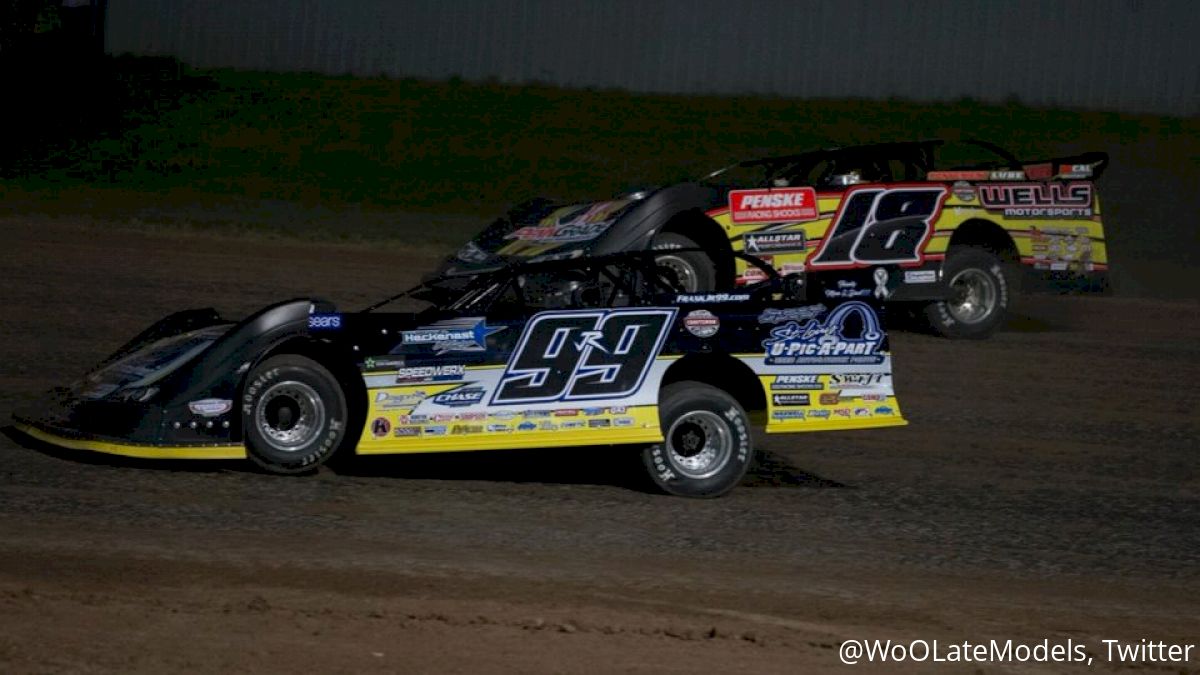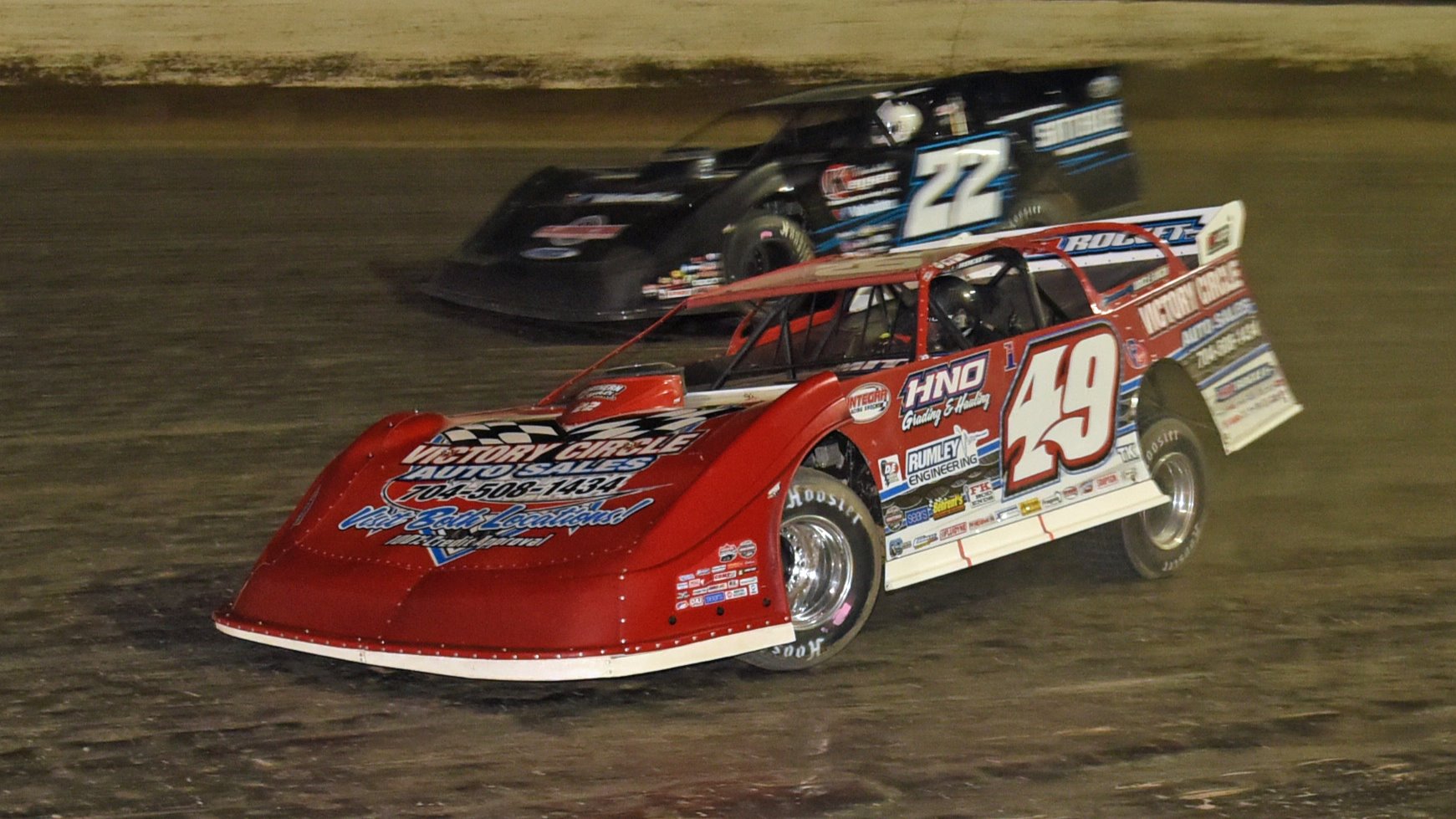It Takes Aggressive Driving to Win Big
It Takes Aggressive Driving to Win Big
Throttle-heavy drivers who turn in a good qualifying lap are going to be in a good spot for the feature.

By Jonathon Masters
Another year is nearly in the books for Dirt Late Model racing in America.
It has been another wild season full of surprise winners and rising stars. The big names of yesterday still seem to crank out some big wins, but that is becoming less frequent. One constant across the board is that the drivers finding themselves in Victory Lane seem more and more prone to aggressive and throttle-heavy driving styles.
There was a time in the 1980s and 1990s when driving a Dirt Late Model took more finesse. Drivers with great throttle control and masterful skill maneuvering through the field were the ones hoisting the checkered flag the most. It was the era of Jack Boggs, Billy Moyer, Rick Aukland, Davey Johnson, John Gill, Freddy Smith, and many other fantastic drivers.
After the past two seasons, those days seem more like a distant memory.
Today's winning drivers are fearless and hard on the throttle of their speed machines. The driver who goes the farthest into a corner without lifting and makes moves that are as likely to result in a red flag as a checkered flag is the one taking home the money at the end of most big events.
The factors that have contributed to this winning combination are varied, but there are two main items that have paved this road: the rise in competition and evolution of racing equipment. Those two things have changed the way drivers need to perform in order to win.
In the 1980s and 1990s, there was only so much horsepower that could be transferred to the racing surface. The cars broke traction easily and spun the tires on hard throttle, which resulted in excessive wear and slower cars.

Drivers needed to be easier on the gas and know the car's limits. Today the manufacturers and crews have turned Dirt Late Models into bullets. The cars are glued to the track, allowing drivers to stay on the gas and build speed constantly. The motors have more horsepower. The cars have more mechanical traction, and the tires do not give up their grip as easily. The more one can push the car the faster it is going to be in a race.
Aggression behind the wheel pays off.
The other factor is the rise of competition. A lot of fans long for the racing of yesteryear -- romanticizing the cars and drivers as if something has been lost that made racing great.
The truth is today's teams and drivers are faster, smarter, better equipped, and harder racers. These guys are racing against the very best week in and out. They travel farther, which forces them to perform at a higher level to get a return on their investment. Every national team is racing on a budget unthinkable to racers of decades past. The game has changed and racers have adapted.
There is no longer room for a bad qualifying performance. Burying oneself early can result in a junked weekend. The competition is simply too good to start behind in a heat and work to the front. The throttle-heavy driver who turns in a good qualifying lap is going to put himself in a good spot for the feature -- end of story.
There are a few other factors such as tracks adding more water more often to the racing surface to keep it "hammer down." This swings the ball into the court of those who are better in tacky situations and less so to those who excel in the slicker conditions.
It took a group effort to cause this change in racing, and Dirt Late Model fans have reaped the reward.
- Jonathon Masters has a lifelong connection with dirt racing. His family has owned and operated MasterSbilt Race Cars manufacturing dirt late model chassis for 35 years. He attended college in North Carolina for motor sports management and has written for various industry publications. Jonathon was an account executive at The International Motorsports Industry Show, founder of the Heartland Auto Racing Show, and has been a racing industry professional for over a decade.
Getting Beyond The Hype
How Dirt Track Racing Gets Sponsorship Wrong, Part 1: Tracks & Series | Part 2: Drivers & Teams
Drivers Weigh In About The Scales
Finding Help For Modified Racing
To Race In 2018, Kahne Must Find A Sponsor
Ryan Blaney Fits Best With Penske
The Iconic Brickyard 400 Needs A Boost
Big Changes Are Coming For NASCAR
Sign up for our newsletter to stay current on all the latest racing news and your favorite content from FloRacing.
Another year is nearly in the books for Dirt Late Model racing in America.
It has been another wild season full of surprise winners and rising stars. The big names of yesterday still seem to crank out some big wins, but that is becoming less frequent. One constant across the board is that the drivers finding themselves in Victory Lane seem more and more prone to aggressive and throttle-heavy driving styles.
There was a time in the 1980s and 1990s when driving a Dirt Late Model took more finesse. Drivers with great throttle control and masterful skill maneuvering through the field were the ones hoisting the checkered flag the most. It was the era of Jack Boggs, Billy Moyer, Rick Aukland, Davey Johnson, John Gill, Freddy Smith, and many other fantastic drivers.
After the past two seasons, those days seem more like a distant memory.
Today's winning drivers are fearless and hard on the throttle of their speed machines. The driver who goes the farthest into a corner without lifting and makes moves that are as likely to result in a red flag as a checkered flag is the one taking home the money at the end of most big events.
The factors that have contributed to this winning combination are varied, but there are two main items that have paved this road: the rise in competition and evolution of racing equipment. Those two things have changed the way drivers need to perform in order to win.
In the 1980s and 1990s, there was only so much horsepower that could be transferred to the racing surface. The cars broke traction easily and spun the tires on hard throttle, which resulted in excessive wear and slower cars.

Drivers needed to be easier on the gas and know the car's limits. Today the manufacturers and crews have turned Dirt Late Models into bullets. The cars are glued to the track, allowing drivers to stay on the gas and build speed constantly. The motors have more horsepower. The cars have more mechanical traction, and the tires do not give up their grip as easily. The more one can push the car the faster it is going to be in a race.
Aggression behind the wheel pays off.
The other factor is the rise of competition. A lot of fans long for the racing of yesteryear -- romanticizing the cars and drivers as if something has been lost that made racing great.
The truth is today's teams and drivers are faster, smarter, better equipped, and harder racers. These guys are racing against the very best week in and out. They travel farther, which forces them to perform at a higher level to get a return on their investment. Every national team is racing on a budget unthinkable to racers of decades past. The game has changed and racers have adapted.
There is no longer room for a bad qualifying performance. Burying oneself early can result in a junked weekend. The competition is simply too good to start behind in a heat and work to the front. The throttle-heavy driver who turns in a good qualifying lap is going to put himself in a good spot for the feature -- end of story.
There are a few other factors such as tracks adding more water more often to the racing surface to keep it "hammer down." This swings the ball into the court of those who are better in tacky situations and less so to those who excel in the slicker conditions.
It took a group effort to cause this change in racing, and Dirt Late Model fans have reaped the reward.
- Jonathon Masters has a lifelong connection with dirt racing. His family has owned and operated MasterSbilt Race Cars manufacturing dirt late model chassis for 35 years. He attended college in North Carolina for motor sports management and has written for various industry publications. Jonathon was an account executive at The International Motorsports Industry Show, founder of the Heartland Auto Racing Show, and has been a racing industry professional for over a decade.
Exclusive Content
Weekly Columns by Jonathon Masters
What the World 100 Will Cost YouGetting Beyond The Hype
How Dirt Track Racing Gets Sponsorship Wrong, Part 1: Tracks & Series | Part 2: Drivers & Teams
Drivers Weigh In About The Scales
Finding Help For Modified Racing
Weekly Columns by JD Hellman
Who Will Be The Next Dale Jr.To Race In 2018, Kahne Must Find A Sponsor
Ryan Blaney Fits Best With Penske
The Iconic Brickyard 400 Needs A Boost
Big Changes Are Coming For NASCAR
Like what you see?
Sign up for our newsletter to stay current on all the latest racing news and your favorite content from FloRacing.